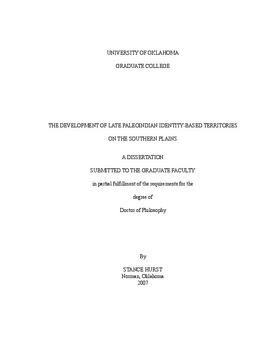| dc.contributor.advisor | Wyckoff, Don G., | en_US |
| dc.contributor.author | Hurst, Stance. | en_US |
| dc.date.accessioned | 2013-08-16T12:20:34Z | |
| dc.date.available | 2013-08-16T12:20:34Z | |
| dc.date.issued | 2007 | en_US |
| dc.identifier.uri | https://hdl.handle.net/11244/1152 | |
| dc.description.abstract | Projectile point styles become more diverse across North America during the late Paleoindian period. Researchers have thought this increase in diversity is part of a regionalization process related to environmental change and/or an increase in population density. A decrease in mobility, reduced territory size, widening of diet breadth, and the formation of ethnic groups are potential results of regionalization. Each of these possible changes are interrelated, and are examined from the perspective of identity based territories in this dissertation. | en_US |
| dc.description.abstract | Carbon isotopes and pollen from 34GR4 supports previous research that a significant environmental change occurred ca. 11,000 RCYBP. This indirectly suggests an increase in population density more likely explains the development of more circumscribed territories. Excavation at the Howard Gully site uncovered a shallow side-notched point in association with one to two bison dating to ca. 10,200 years ago. This point style had previously not been well dated, and suggests interactions with eastern woodland groups where this point style is more common. Work at the Perry Ranch site uncovered evidence of a large bison kill, and a gully was used for trapping the bison. This provides a better context for the Perry Ranch site then what was previously known. Projectile point analysis identified possible territorial boundaries during the late Paleoindian period. Also a reduction in territory size during this period was evident. The sum of these results indicates that prior assumptions about the regionalization process during the late Paleoindian period are true. However, these are tentative results and the story will likely become more complex as we make new discoveries. | en_US |
| dc.description.abstract | A combination of excavation and analysis of surface collected projectile points from the Southern Plains were used for determining if late Paleoindians were becoming more regionalized. Excavations were conducted at Rattlesnake slough (34GR4), Howard Gully (34GR121), and Perry Ranch (34JK81) sites in southwestern Oklahoma to uncover chronological information, environmental data, and features. A total of 860 spear points from six localities and late Paleoindian sites across the Southern Plains were examined for delineating late Paleoindian territorial boundaries. | en_US |
| dc.format.extent | xx, 248 leaves : | en_US |
| dc.subject | Human territoriality Oklahoma. | en_US |
| dc.subject | Antiquities, Prehistoric Oklahoma. | en_US |
| dc.subject | Anthropology, Archaeology. | en_US |
| dc.subject | Land settlement patterns, Prehistoric Oklahoma. | en_US |
| dc.subject | Ethnoarchaeology Oklahoma. | en_US |
| dc.subject | Oklahoma Antiquities. | en_US |
| dc.subject | Projectile points Oklahoma. | en_US |
| dc.subject | Social archaeology Oklahoma. | en_US |
| dc.subject | Paleo-Indians Oklahoma. | en_US |
| dc.title | The development of late Paleoindian identity-based territories on the Southern Plains. | en_US |
| dc.type | Thesis | en_US |
| dc.thesis.degree | Ph.D. | en_US |
| dc.thesis.degreeDiscipline | Department of Anthropology | en_US |
| dc.note | Adviser: Don G. Wyckoff. | en_US |
| dc.note | Source: Dissertation Abstracts International, Volume: 68-01, Section: A, page: 0235. | en_US |
| ou.identifier | (UMI)AAI3249639 | en_US |
| ou.group | College of Arts and Sciences::Department of Anthropology | |
